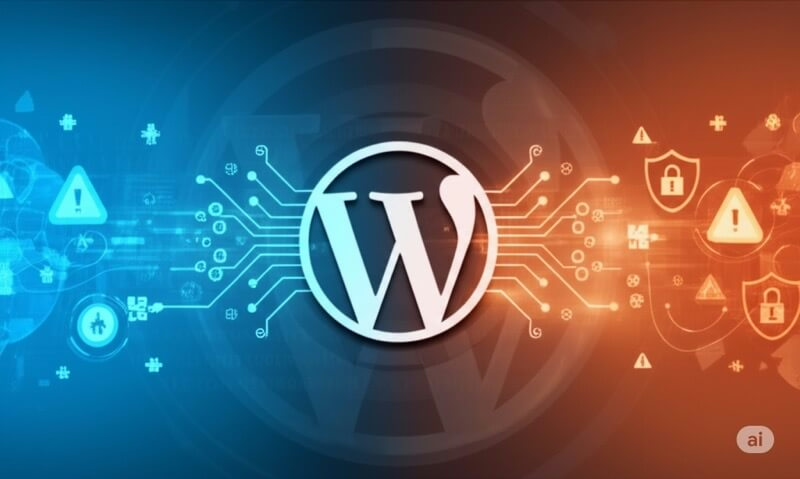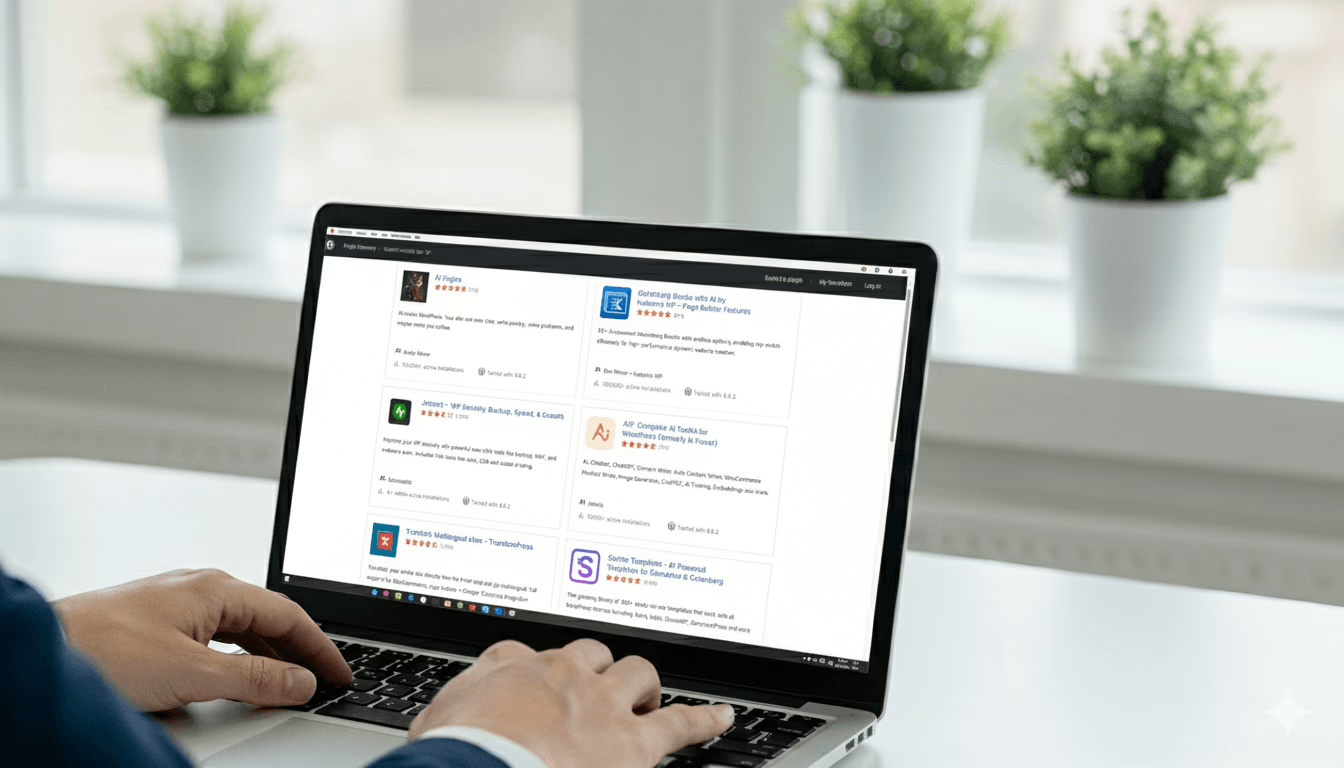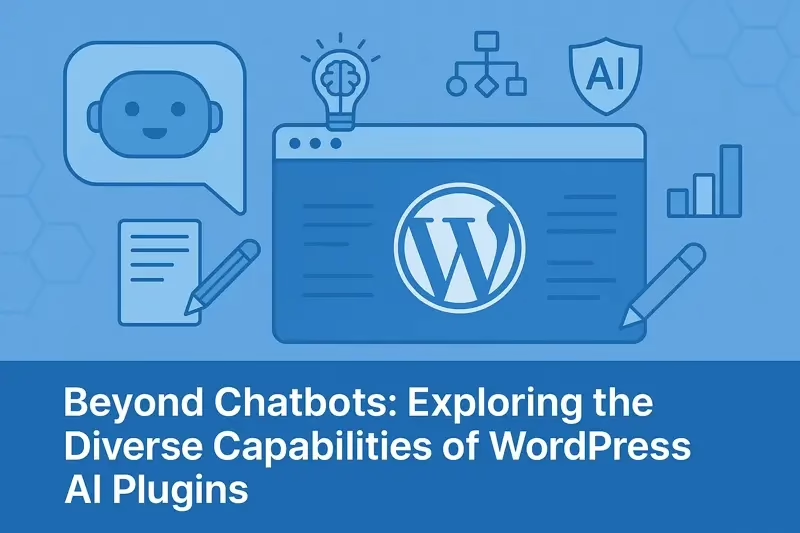WordPress AI Team Launch: What You Need to Know
WordPress just announced something that should have every website owner paying attention. After 22 years of powering the web, WordPress has officially launched a dedicated AI team to accelerate the integration of artificial intelligence across its entire ecosystem. This isn’t just another tech update. It’s a fundamental shift that validates what forward-thinking businesses already know: WordPress AI optimization is no longer optional.
But here’s where things get interesting. In the same week that WordPress revealed its ambitious AI plans, the platform was hit with 241 new security vulnerabilities across its plugins and themes. Think about that for a moment. While WordPress is racing toward an AI-powered future, hundreds of existing sites remain vulnerable to basic security threats.
This perfect storm of innovation and vulnerability creates a unique moment for WordPress site owners. You’re watching the platform evolve into something more powerful than ever before, while simultaneously being reminded that the fundamentals still matter. The businesses that thrive will be those that master both sides of this equation: embracing WordPress AI capabilities while maintaining a rock-solid security foundation.
In this deep dive, you’ll discover what WordPress’s new AI team means for your business, why this timing matters more than you might think, and exactly how to position your site for success in both the short and long term. Whether you’re running a small business website or managing enterprise WordPress installations, these changes will impact how you approach online visibility, customer engagement, and competitive advantage.
WordPress AI Team Formation: The Official Story
On May 27, 2025, WordPress Executive Director Mary Hubbard made an announcement that sent ripples through the development community. According to the official WordPress.org announcement, WordPress was forming an official AI team, bringing together four seasoned contributors to coordinate artificial intelligence projects across the entire WordPress ecosystem.
This isn’t a small internal experiment. The team includes heavy hitters such as James LePage from Automattic (Director of AI Engineering), Felix Arntz and Pascal Birchler (both Google-sponsored WordPress core contributors), and Jeffrey Paul from 10up (Director of Open Source). These aren’t random selections – they’re established leaders who’ve already been driving significant WordPress improvements for years.
Key Questions About WordPress AI Development:
• What’s the timeline for new features? The plugin-first approach means beta tools could arrive within 6-12 months
• Will these tools be free? Following WordPress tradition, canonical plugins will likely be open source
• How will they handle privacy concerns? The team emphasizes developing “responsibly and in the open”
• What about existing AI plugins? Third-party tools will coexist, but canonical options may become preferred standards
The team’s mission centers on what Hubbard calls stewarding AI “responsibly and in the open.” Unlike proprietary platforms that develop AI features behind closed doors, WordPress AI development will follow the same transparent, community-driven approach that built the platform into what it is today. This means WordPress AI tools will be developed as canonical plugins first, allowing for rapid iteration and community feedback before any core integration.
What makes this announcement particularly significant is the strategic timing. WordPress isn’t playing catch-up here. They’re establishing leadership while AI adoption is still accelerating. The team plans to publish a public roadmap of WordPress AI initiatives, develop standards for AI integration, and ensure all new features meet accessibility, privacy, and usability guidelines.
For businesses already investing in AI strategy consulting, this validates a critical decision. WordPress AI isn’t just coming; it’s being built by the same people who have made WordPress the most trusted platform on the web. The plugin-first approach means early adopters will have access to cutting-edge WordPress AI tools months or even years before they become standard features.
According to TechCrunch’s coverage of the announcement, this formalized approach signals that WordPress wants to take an active role in organizing and moderating AI efforts among developers. Rather than leaving WordPress AI development entirely to third parties, the platform is now directly investing in coordinated innovation.
The Security Reality Check: 241 Vulnerabilities in One Week
While WordPress was announcing its AI future, security researchers were documenting one of the most concentrated vulnerability crises in recent memory. In the same week as the AI team launch, 241 new security flaws were reported across 222 plugins and 19 themes. To put this in perspective, that’s roughly one vulnerability discovered every hour for an entire week.
Immediate Security Assessment Checklist:
• Check your plugin versions against the SolidWP vulnerability database
• Update Ocean Extra to version 2.4.7 if you’re running it (fixes XSS vulnerability)
• Verify Element Pack Addons is updated to v5.10.30 or later
• Review Jupiter X Core and ensure you have v4.8.12 minimum
• Disable any plugins listed as “unpatched” in recent security reports
• Enable automatic updates for trusted, frequently maintained plugins
The numbers tell a sobering story. Of those 241 vulnerabilities, only 91 had patches available at the time of disclosure. That means 150 security holes remained completely unpatched, leaving potentially thousands of sites exposed to attack. According to SolidWP’s comprehensive vulnerability report, over 60% of these WordPress AI-era security issues had no immediate solution.
Some of the affected plugins are widely used. Ocean Extra (600,000+ installations) had a reflected XSS vulnerability. Element Pack Addons for Elementor (with over 100,000 installations) contained cross-site scripting flaws. Even Jupiter X Core (90,000 installations) suffered from a critical PHP Object Injection vulnerability. While patches were eventually released for these popular extensions, the window of exposure demonstrates how quickly security situations can escalate.
The unpatched vulnerabilities present even greater concerns. Smaller plugins, such as Advanced Accordion Gutenberg Block and Lottie Player, each contain XSS vulnerabilities with no available fixes. The security advice for these tools is stark: disable them immediately or accept the risk of potential compromise.
This security crisis isn’t just bad timing – it’s a reality check about WordPress ecosystem management. As platforms rush to implement WordPress AI features, the foundation still needs constant attention. Attackers are increasingly using AI tools themselves to automate vulnerability discovery and exploitation. According to security experts at Wordfence, malicious actors can now scan for and exploit WordPress vulnerabilities faster than ever before.
The irony is unmistakable. While WordPress AI teams work to make websites smarter and more capable, hackers are using similar technologies to find and exploit weaknesses more efficiently. This creates a new arms race, where security becomes even more critical as AI capabilities continue to expand.
What This Means for Your WordPress AI Strategy
The simultaneous launch of WordPress’s AI team and the discovery of widespread vulnerabilities creates a unique strategic moment. For business owners, this isn’t just about choosing between innovation and security. It’s about understanding how these forces work together to shape your competitive position.
Strategic Questions to Consider:
• Is your current site secure enough to handle advanced WordPress AI features safely?
• What WordPress AI capabilities would provide the most immediate business value?
• How will you evaluate new AI plugins for both functionality and security?
• Do you have staging environments for testing WordPress AI tools before deployment?
• What’s your timeline for implementing WordPress AI optimization strategies?
First, the WordPress AI team formation validates something we’ve been advocating at AgenticPress: AI optimization is becoming essential infrastructure, not optional enhancement. When WordPress dedicates core resources to AI development, they’re signaling that WordPress AI search optimization will become as fundamental as responsive design or SSL certificates.
The timing also creates an opportunity. While many businesses wait to see what WordPress AI features emerge, early movers can establish advantages by implementing optimization strategies now. The canonical plugins developed by WordPress’s AI team will likely build on existing standards for structured data, semantic markup, and content organization, precisely the areas where comprehensive AI search optimization provides immediate benefits.
However, the security crisis adds an essential dimension to any WordPress AI strategy. Your site’s AI readiness means nothing if basic security vulnerabilities make it a target for attack. The businesses that succeed will be those who can advance their WordPress AI capabilities while maintaining enterprise-level security practices.
This dual challenge favors professional implementation over DIY approaches. WordPress AI optimization requires understanding both emerging technologies and fundamental security principles. It’s not enough to install AI plugins; you need to evaluate their security implications, monitor their update cycles, and integrate them into a comprehensive site management strategy.
The market dynamics are also shifting. As WordPress AI becomes more mainstream, the competitive advantage will belong to sites that implement these capabilities early and securely. According to industry research on AI adoption in CMS platforms, the WordPress AI plugin market is projected to reach $500 million by 2025 with a 25% compound annual growth rate. Your competitors are likely watching these developments too, which means the window for establishing WordPress AI leadership in your market may be shorter than you think.
How to Prepare Your Site for the WordPress AI Revolution
Successfully navigating this WordPress AI transition requires a systematic approach that addresses both innovation and security. Based on current developments and security best practices, here’s your roadmap for WordPress AI readiness.
Security Foundation Checklist:
• Audit all installed plugins and themes for known vulnerabilities
• Remove or replace any unmaintained extensions (no updates in 6+ months)
• Install a comprehensive security plugin (Wordfence, Sucuri, or iThemes Security)
• Enable Web Application Firewall protection at the plugin or hosting level
• Configure automatic backups with off-site storage (daily minimum)
• Update WordPress core to the latest version immediately when available
• Review user permissions and remove unnecessary admin access
• Implement two-factor authentication for all admin accounts
Start with a comprehensive security audit of your current WordPress installation. Before adding any WordPress AI capabilities, ensure your foundation is solid. This means updating all plugins and themes to their latest versions, removing any extensions that haven’t been updated recently, and implementing a Web Application Firewall (WAF) to protect against known vulnerabilities.
Pay special attention to the plugins listed in recent vulnerability reports. If you’re running Ocean Extra, Element Pack Addons, or any of the other affected extensions, verify you have the patched versions installed. For plugins with no available fixes, the safest approach is to deactivate them until patches are released temporarily.
WordPress AI Readiness Action Items:
• Implement comprehensive schema markup across all content types
• Optimize content structure with clear headings and semantic HTML
• Create FAQ sections that directly answer common customer questions
• Establish consistent internal linking strategies between related content
• Develop content workflows that prioritize comprehensive, authoritative information
• Set up staging environments for testing new WordPress AI tools safely
• Monitor WordPress AI team roadmap announcements for early access opportunities
Next, optimize your content structure for WordPress AI systems. The upcoming canonical AI plugins will likely prioritize sites with clean semantic markup, comprehensive schema implementation, and well-organized content hierarchies. This is where a professional WordPress website design focused on AI readiness provides significant advantages.
Implement comprehensive schema markup across your site. WordPress AI systems will need to understand the context, relationships, and meaning of your content. Product schema, Organization schema, FAQ schema, and LocalBusiness schema (where applicable) create the structured data foundation that AI tools require for accurate content interpretation.
Monitor the WordPress AI team’s public roadmap as it develops. Early access to beta plugins and development previews can provide a competitive advantage, but only if you have the necessary technical infrastructure to test and implement new features safely. Consider establishing a staging environment specifically for WordPress AI experimentation.
Questions for Evaluating New AI Tools:
• Who developed this plugin, and what’s their security track record?
• How frequently is it updated, and does the developer respond to security issues?
• What data does it collect, and where is it processed?
• Does it require external API connections, and how are they secured?
• Is the code open source and available for security review?
• What happens if the plugin is discontinued or the company fails?
Establish content workflows that align with AI optimization principles. This involves creating comprehensive, authoritative content that directly addresses user questions, implementing consistent internal linking strategies, and ensuring content freshness through regular updates. The AISO process we use with clients addresses these requirements systematically.
Finally, develop monitoring systems for both WordPress AI performance and security. As new AI features become available, you’ll need ways to measure their impact on user engagement, search visibility, and business outcomes. Simultaneously, ongoing security monitoring becomes even more critical as your site’s capabilities expand.
The Future of WordPress AI: What’s Coming Next
The WordPress AI team’s roadmap promises significant developments over the next 12-18 months. Based on their plugin-first approach and stated priorities, we can expect to see canonical tools for content generation, image optimization, and user experience personalization. These won’t be experimental features. They’ll be production-ready tools designed to integrate seamlessly with existing WordPress workflows.
Anticipated WordPress AI Developments:
• Content generation plugins for automated writing assistance and optimization
• Image AI tools for automatic alt text, compression, and SEO optimization
• User experience personalization based on visitor behavior and preferences
• Security AI features for automated threat detection and vulnerability scanning
• Search optimization tools that automatically implement AISO best practices
• Performance AI for dynamic caching and resource optimization
Community reaction to the WordPress AI announcement has been overwhelmingly positive. Long-time contributor Tammie Lister captured the sentiment well, noting that after 22 years, WordPress needs to “start thinking about how to approach the future” and “chart what lies ahead.” This isn’t just about keeping up with trends – it’s about maintaining WordPress’s position as the web’s most innovative platform.
The security challenges will likely accelerate the development of AI-powered security tools as well. WordPress AI capabilities could include automated vulnerability scanning, intelligent firewall rules, and predictive threat detection. The same technologies that create new possibilities for content and user experience can also strengthen the platform’s security infrastructure.
For businesses, this evolution means WordPress AI optimization will transition from a competitive advantage to a competitive necessity. Early implementation provides the greatest benefits, but the window for establishing leadership is finite. As canonical WordPress AI tools become standard, the advantage shifts to organizations that have already optimized their content, technical infrastructure, and workflows for AI systems.
The trajectory is clear: WordPress AI will become as fundamental to web presence as search engine optimization is today. The businesses that recognize this shift early and invest in comprehensive preparation will be best positioned to leverage these capabilities as they mature.
Conclusion
WordPress’s launch of an official AI team marks a pivotal moment for every business with a web presence. This isn’t just another platform update. It’s validation that WordPress AI optimization has become essential infrastructure for online success. The timing, coinciding with significant security challenges, creates both urgency and opportunity for forward-thinking organizations.
The lesson from this moment is clear: innovation and fundamentals must advance together. The most successful WordPress sites will be those that embrace WordPress AI capabilities while maintaining uncompromising security standards. This dual focus requires professional expertise, systematic implementation, and ongoing optimization, exactly what distinguishes thriving businesses from those that struggle with technological transitions.
Your competitors are watching these developments too. The advantage belongs to organizations that act decisively, implementing WordPress AI optimization strategies before they become standard practice. The canonical tools being developed by WordPress’s AI team will build on the same principles we’ve been advocating: structured content, semantic markup, and comprehensive optimization for both traditional and AI-powered search systems.
The WordPress AI revolution is here. The question isn’t whether your business will need to adapt; it’s whether you’ll lead the transition or follow it. Smart money is on getting ahead of these changes while the competitive advantages are still available.


